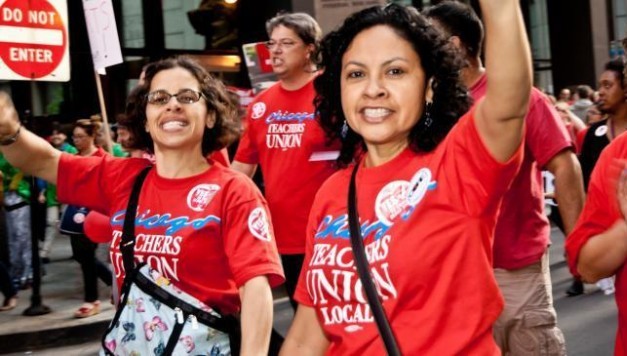Occupy brought a discussion about economic inequality to the forefront of political debate in this country. Importantly, the movement named an enemy: the richest 1%, the people hoarding cash, buying politicians, becoming politicians and getting bailed out by the government. Meanwhile, the rest of us, the 99%, form the vast majority and are getting ripped off by those at the top. But figuring out a strategy to change the world requires that we must go deeper in our understanding of inequality, class, and power in society. This question is made even sharper by the events of April 15, when tens of thousands of low-wage workers came out on the streets in over 200 cities across the U.S. in the biggest day of action yet for the union-backed Fight for 15. Even the corporate-dominated media talked about this as indicating the potential for the reemergence of the labor movement as a serious force in U.S. society. We in Socialist Alternative also see this potential, as well the huge challenges ahead.
The Working Class
The corporate-dominated media wants us to believe that we’re all “middle class” and that the working class is a thing of the past. However, socialists say that people who have to work for an employer in order to live, from a well-paid engineer to a low-paid dishwasher, are all part of the working class. Working people produce the vast wealth of society, but we only receive a small part of that in our wages, while the employers, especially the capitalists, extract huge profits from our labor.
Socialists see working people as the central force to change the world and end all forms of oppression. This isn’t out of some nostalgia for categories of the past. To change the world, we must first understand it: who has the potential power in society, who is exploited, and who has the capacity to fight back and win.
The working class is the vast majority of society. We build everything; we make everything; we transport everything; we provide all the services, teach all the kids, open all the cash registers, clean all the floors, mend the sick, and cook and serve the food. We do everything that makes this system run, and if we’re sufficiently well organized, we can force the employers to make significant concessions by shutting down key areas of the economy and mobilizing ourselves as an independent political force. Ultimately, we can use this power to transform society.
Why Unions Matter
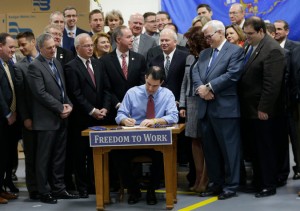
While the working class is not yet organized enough to bring about decisive change through mass strike action or electing a government of workers’ representatives, we do have power in collective organization. Unions are the strongest organizations we have to improve our living standards, but they are declining in membership, almost never take strike action, and are under attack from laws undermining our right to fight. With Wisconsin Governor Scott Walker recently signing “right to work” into law, fully half of all states now have laws severely hampering trade union activity.
The super-rich attack unions for a reason: they know what unions have done in the past to undermine super-profits and improve the lives of working people. Unions make the working class stronger because, in unions, we can bargain together, instead of as individuals, for better benefits and pay. When strike action is necessary, a well-organized union is indispensable. When unions are strong, wages even for nonunion workers go up, as the bosses give concessions to cut off the desire of workers to organize. In the past, unions won the abolition of child labor, the eight-hour day, the five-day workweek – establishing the weekend! – as well as massive improvements in workplace safety.
Unions give workers a sense of their collective power and their shared interests in opposition to the billionaire class. They point toward reorganizing society on the basis of solidarity and cooperation, not the markets.
As unions have declined in the last historical period, workers have been forced to work longer hours with forced overtime, working conditions are becoming more dangerous, and “benefits” like good health plans and pensions are increasingly a thing of the past.
While understanding the potential power of the working class and the labor movement, we need to work out effective strategies to address the huge changes in the workforce that have taken place in the last period.
Assault on Our Organizations, Our Living Standards
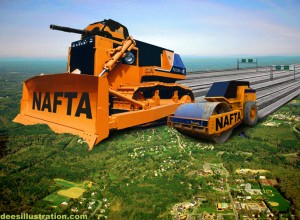 The last forty years have seen a huge shift toward “globalization” – including removing restrictions on capital flows and trade. Trade deals like the North American Free Trade Agreement (NAFTA) have been done at the expense of workers, at the expense of both in “advanced” and developing countries. Neoliberal policies were implemented in country after country, leading to privatization of huge parts of state services, attacking the historic gains of working people, implementing austerity, and – inevitably – leading to a massive increase in inequality.
The last forty years have seen a huge shift toward “globalization” – including removing restrictions on capital flows and trade. Trade deals like the North American Free Trade Agreement (NAFTA) have been done at the expense of workers, at the expense of both in “advanced” and developing countries. Neoliberal policies were implemented in country after country, leading to privatization of huge parts of state services, attacking the historic gains of working people, implementing austerity, and – inevitably – leading to a massive increase in inequality.
During the decades-long onslaught against working people, union leaders made huge concessions to employers, giving away high wages and benefits. It was argued that it was necessary to give up good wages and benefits in order to persuade companies to keep production in the country. But the jobs disappeared anyways, many to “outsourcing” but most due to automation. Union density dropped sharply. Industrial workers who were still unionized were increasingly disengaged from their union structures after experiencing decades of sellout contracts with no fights. High-wage union jobs were shipped out by the thousands, with little to no resistance put up by unions or their leaders. Now, in the current “recovery,” we face a situation where the vast majority of new jobs being created pay low wages.
Well-Paid Workers
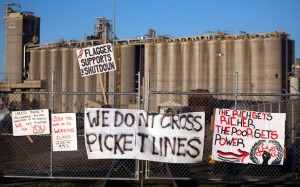
Despite the vast decline in the number of unionized workers and of the industrial workforce, the industrial working class still has massive potential power. Workers in industry still make up nearly 20% of the overall workforce, and some industrial unions continue to wield real power. For example, the International Longshore and Warehouse Union (ILWU) has the ability to shut down the West Coast ports, through which over 40% of U.S. trade moves.
Many unionized industrial and manual workers are very well-paid in comparison to many young people entering the workforce now, but this doesn’t mean that they’re “middle class.” Socialists don’t define class based on how much money you make; we define it based on who you work for, how you get paid, and what you do at work. Again, in order to survive, workers have no choice but to sell to the employer their ability to work. Dockworkers are well-paid because they fought their employers through unionization and strikes.
Many people see themselves not as workers, but as professionals. But socialists see a distinction between skilled workers, like nurses, and top managers, whose role it is to control a workforce and squeeze as much productivity out of them for as little cost as possible.
Some jobs that were previously well-paid due to unionization are now being ushered into the low-wage workforce. This is true of many truckers and auto workers. Many of these workers, if organized, could choke corporate profits considerably. For instance, many business plans run on tight timescales, with “just in time” shipping. A strike, or even a slowdown, of warehouse workers and truckers could make all the Walmarts and big grocery chains shake in their boots while looking at potential lost profits.
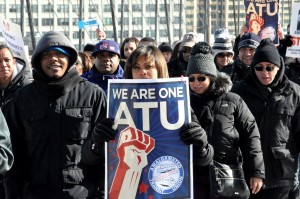
The concentration of workers in the big urban centers greatly increases the potential power of the working class. But this would mean the unions reaching out to build powerful solidarity actions and launching new organizations of struggle that can help others get organized and win. For example, transit workers throughout the country, organized mostly into the Amalgamated Transit Union (ATU), have a leadership that is more focused than most on organizing and building movements. ATU is one of the few unions to have come out against the Keystone XL pipeline, connecting with the broader environmental movement and the community’s desire for cheap, high-quality mass public transit that would benefit both the union in good jobs created and the environment in less greenhouse gases emitted. Coalitions of unions and the broader community, fighting for better conditions in society, can be a model to mobilize millions into action.
Hospitals and schools have become increasingly privatized, as the super-rich try to make money off of anything – our sickness, our children’s future. This process of squeezing our vital services has also led to more and more people who previously saw themselves as only professionals – nurses, teachers, etc. – getting organized and fighting back.
Fighting to Transform the Unions
The long retreat and decline of the unions in the U.S. over the past four decades and the largely ineffective policies of most union leaders have, unfortunately, created a situation where the bulk of the remaining unions lack a dynamic internal life. Real democratic control of the unions by their members is a precondition for developing the kind of fighting approach essential to rebuilding union strength.
Many top union leaders are paid far, far more than the workers they represent. This means that they are out of touch with the day-to-day reality of their members. We advocate that elected union leaders are paid the average wage of the workers they represent; they should receive increases when their members do. They should be subject to recall at any time and held accountable by their members.
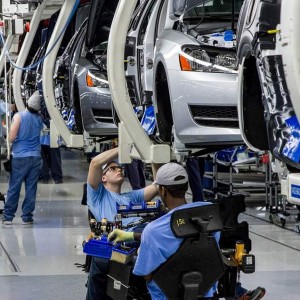
A tragic example of a union with a heroic, fighting past which has ended up agreeing to seemingly endless concessions is the United Auto Workers (UAW). New hires in the “Big Three” American automakers represented by the UAW now only make $16 an hour! By contrast, the National Nurses Union (NNU), which was only formed in 2009, has fearlessly advocated bold reforms that would benefit working people generally, refused to tailor its message to suit Democratic Party politicians, and it has not been afraid to call its members out on strike in defense of their interests.
Rebuilding unions as fighting organizations requires building an alternative to the present dominant current in labor: We need leaders who base themselves on the collective power of the membership, fight back against the ongoing attacks of the top 1%, and don’t accept the limitations of what the bosses and their system say they can afford. In many cases, this requires building coherent left opposition groupings in existing unions. In other cases, it will require building new organizations. This is where socialists have a crucial role to play within the workers’ movement: to offer such an alternative and to fight to rebuild the unions on such a basis.
Turning the Tide: Perspectives for Struggle
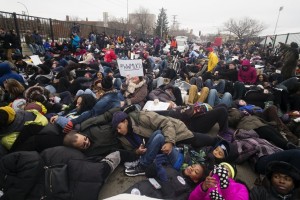
Despite the overall retreat, some working-class organizations, like the Chicago Teachers Union and the NNU, have been influenced by radical activists and have leaders who want to fight back. With the renewed discussion on inequality, thousands of young people have been radicalized, getting involved in the Occupy movement or Black Lives Matter. A new generation is entering into an economic crisis and an uncertain future.
Occupy and Black Lives Matter are two movements that indicate the likelihood of increased class struggle. In the 1970s, activists who went through the antiwar, women’s liberation, civil rights, and black power movements struggled to transform unions. These years saw some of the highest strike figures in the history of the country. A similar climate could be emerging now, but in the context of a deep economic crisis and potentially explosive struggles.
Community protest campaigns supported by unions can ignite truly mass struggles. The immigrant rights movement of 2006 led to mass strike action which shut down ports and thousands of businesses throughout the country. The key organizations in the fight for a $15 minimum wage, including Fast Food Forward and 15 Now, are all centered on workers outside the unions but supported by key unions. To win real gains, low-paid workers will need to build their own democratic fighting organizations that are committed to taking forward their struggles. Organizing in fast food and the vast service sector poses many complex challenges. But the massive energy on the streets across the country on April 15 shows that there is a tremendous desire to fight and overcome these obstacles.
Political Representation
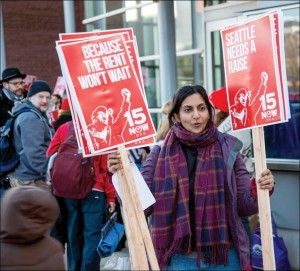
In every serious struggle, unions not only clash with individual bosses, but with their media, their politicians, and the police used in the interests of the top 1%. This is a political battle. Most union leaders today avoid this issue and do all they can to trail the big-business Democratic Party as a lesser evil to the right wing. This is one of the reasons why the working class is isolated politically in the U.S. but the anti-establishment mood is there to rally millions to fight against corporate rule.
With over 90,000 votes, Kshama Sawant’s 2013 election as the first socialist member of the Seattle City Council in over 100 years spurred a battle to increase the city’s minimum wage to $15 an hour. Winning $15 in Seattle last June has inspired similar fights in cities throughout the country. To build on these victories and take advantage of the anger at the establishment, we need a mass working-class party, supported by fighting labor organization and community groups, to run hundreds of candidates who challenge the right-wing attacks of the Republicans and the inept response of the corporate-dominated Democratic Party.
Movements against discrimination, as in the 1960s and 1970s, can be important sources of new strength for the working class movement, and unions should actively support these fights. Capitalism produces many types of oppression and exploitation beyond class. The increasingly black and Latino working class is at the center of all production, distribution, and services, the exploitation of which produces all corporate profits. Therefore, workers have both the power and the interests to end capitalism and all forms of oppression, even in a country where we’re all told we’re “middle class.”
Young activists radicalizing today to fight against oppression need to learn the lessons of labor history and the terrain of the class battles today. Only with this conscious approach can workers rebuild a fighting labor movement that can lead the struggle to transform society.


